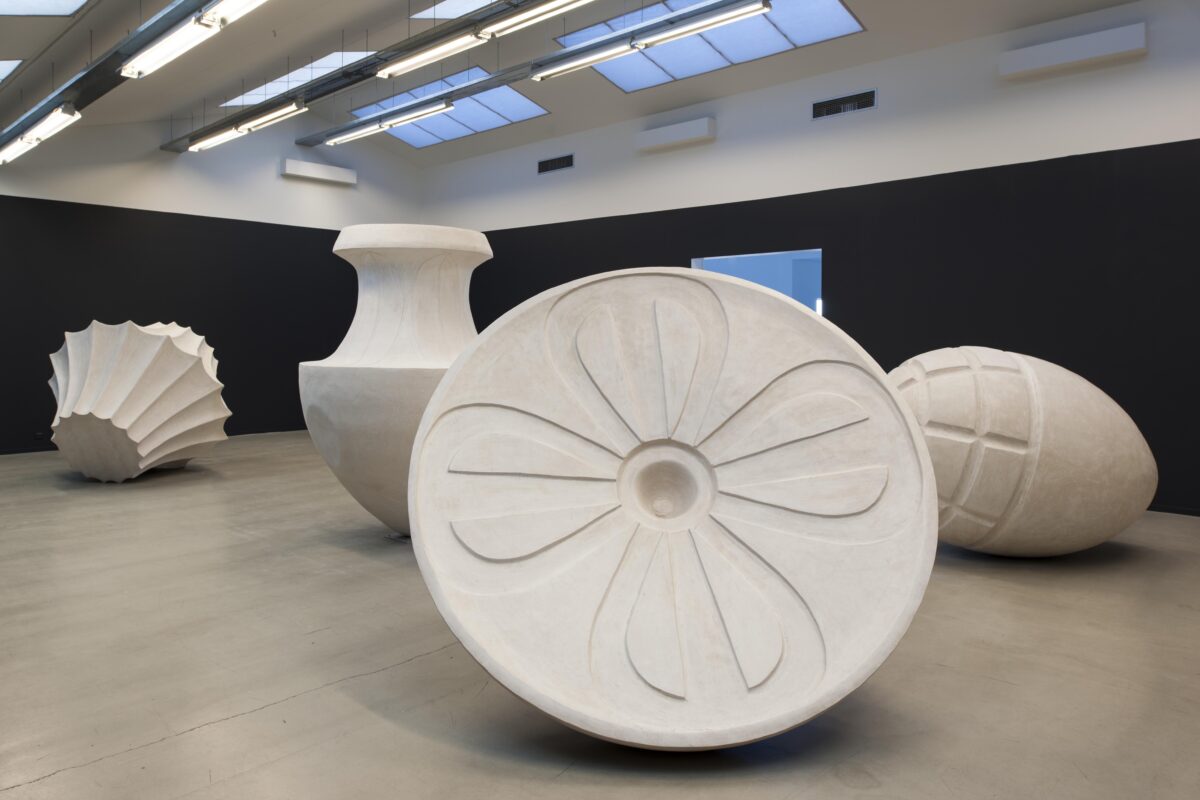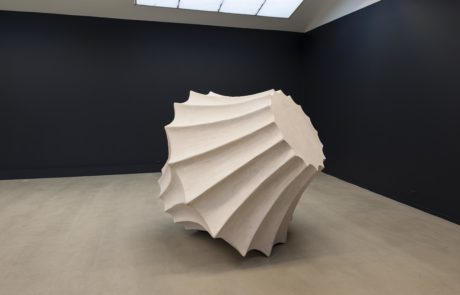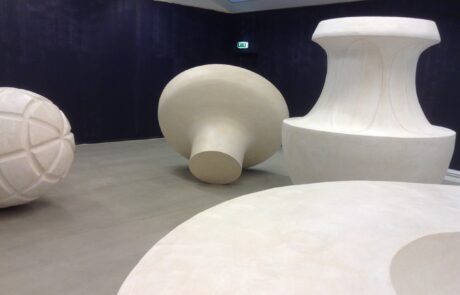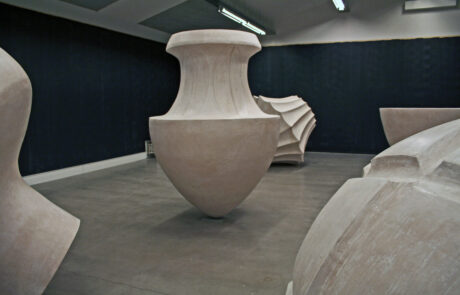
The Dialectical Image
Rósa Gísladóttir
September 28 – December 15, 2013
When, in the summer of 2012, Rósa Gísladóttir exhibited her sculptures in the ruins of the Imperial Fora in Rome, I wrote an essay for the catalogue in which I connected her rendezvous with the ruins of the past to Walter Benjamin’s memorable passage extrapolating on Paul Klee’s painting Angelus Novus: An angel with outspread wings faces the ruins of history, which are piling up before him. He would like to cope with these ruins, assemble and revive them, but can’t stir his wings as they are caught fast, wide open, in a strong wind from Paradise. That wind, Benjamin goes on to say, is what we call progress. (See “Theses on the Philosophy of History,” published in Illuminations, ed. H. Arendt, New York, 1969.)
To Walter Benjamin Angelus Novus is what he often refers to in his writing as a “dialectical image,” a concept that he favoured in his constant struggle against the conception that history and historical studies are the unreconsidered filling-in of facts on a given timeline. In this essay I wish to extend this concept of the dialectical image to Rósa Gísladóttir’s sculpture.
For Benjamin human history is meaningless unless it appears to us in a “still image of history” that flashes up in the historian’s and viewer’s day, transforming the current scene in which they are situated. Thus all Benjamin’s writings are a maze of discrete, discordant fragmentary images which he excavates from the past to illuminate his present. These fragments sometimes miss their mark but now and then images flare up and illuminate a much larger area, illustrating our world and summoning a new one. Benjamin saw himself as a collector of such images and thus his books are like anthologies full of more or less jumbled quotations from myriad authors of different eras. For Benjamin the author’s task is to strive to understand the world and thereby to change it.
To consider Rósa Gísladóttir’s sculptures in light of this key Benjamin concept of the “dialectical image” may prove useful in clarifying their relation to the present and to history. Benjamin offers one explanation of his concept in the following passage from his unfinished magnum opus, Das Passagen Werk, which he worked on continually from 1927 until his death in 1940:
To thinking belongs the movement as well as the arrest of thoughts. Where thinking comes to a standstill in a constellation saturated with tensions—there the dialectical image appears. It is the caesura in the movement of thought. Its position is naturally not an arbitrary one. It is to be found, in a word, where the tension between dialectical opposites is greatest. Hence, the object constructed in the materialist presentation of history is itself the dialectical image. (The Arcades Project, Harvard University Press, 1999, N10a, 3, p. 475, transl. R. Tiedemann.)
And elsewhere:
Where thinking suddenly stops in a configuration pregnant with tensions, it gives that configuration a shock, by which it crystallizes into a monad. A historical materialist approaches a historical subject only where he encounters it as a monad. (“Theses on the Philosophy of History,” Illuminations, pp. 262-3, transl. H. Zohn.)
It is not far-fetched to assert that Gísladóttir’s sculptures are a monad in Benjamin’s sense: forms culled from the detritus of history and placed in daylight, not to resurrect “history” but to illuminate and transform the present. In this sense Gísladóttir’s sculptures are “dialectical images” charged with the tension between two opposites. Their forms derive from the classical world. In the case of the large sculptures the “models” come from the Roman Imperial Fora and Pompeii, 2000 years back in history. These forms reflect a long-since vanished worldview; they stem from a geometry based on notions of universal order. In the present these forms shine with their own light but the immutable natural order that underlay them has vanished. Also lost to present view are the metaphysics that underlay ancient and classical art traditions. In these tensions lies the volatile dialectical charge of Gísladóttir’s sculptures. That charge is also present in her “Still-life” from 1999, which conveys in effect a reduced image of the large sculptures of the Roman fora. In their very immobility these works carry a charge; they form a short-circuit between two worlds.
Though Gísladóttir’s sculptures allude to the classical tradition, they are in no way “neo-classical” in the conventional art-historical sense. While the neo-classicism of 18th and 19th centuries, like Gísladóttir’s works, derived its notions of form from Greco-Roman classicism, it did so on different premises: neo-classicism marks the rupture in art history stemming from the industrial revolution, the Enlightenment, and the French Revolution along with the advent of specialized theories of the beautiful that loosed art from its bonds to religion and to the old society mirrored in the decorative art and rhetoric of the Baroque and Rococo periods. The industrial revolution required new divisions of labour and art was not exempted: art set out anew as an autonomous organ of the new bourgeoisie, ready to serve the new enlightened ruling class, whether of democracy, empire, or monarchy.
Rósa Gísladóttir’s work is utterly different in this regard. These sculptures do not volunteer to serve power, production, or progress. On the contrary they embody the resistance of Benjamin’s dialectical image. They manifest forms from the past that shine with their own light without any metaphysics or reference to any comprehensive worldview. Their effect is rather to make us conscious of the disappearance of the entire comprehensive vision of unerring natural law that Greeks taught as the foundation of all ethical conduct. These works’ geometry and spatiality thus had a deep ethical meaning which our era has relinquished in favour of belief in progress and technology. Gísladóttir’s simple forms carry an afterglow of vanished mores; that glow illuminates a present in which technological capability steers the ecosystem toward ruin.
The American edition of Walter Benjamin’s Illuminations includes Hannah Arendt’s exquisite essay on Benjamin’s life and work. Arendt concludes with words on the “gift of thinking poetically” which I find equally applicable to Rósa Gísladóttir’s way of thinking about form:
This thinking, fed by the present, works with the “thought fragments” it can wrest from the past and gather about itself. Like a pearl diver who descends to the bottom of the sea, not to excavate the bottom and bring it to light but to pry loose the rich and the strange, the pearls and the coral in the depths, and to carry them to the surface, this thinking delves into the depths of the past—but not in order to resuscitate it the way it was and to contribute to the renewal of extinct ages. What guides this thinking is the conviction that although the living is subject to the ruin of the time, the process of decay is at the same time a process of crystallization, that in the depth of the sea, into which sinks and is dissolved what once was alive, some things “suffer a sea-change” and survive in new crystallized forms and shapes that remain immune to the elements, as though they waited only for the pearl diver who one day will come down to them and bring them up into the world of the living—as “thought fragments,” as something “rich and strange,” and perhaps even as everlasting Urphänomene. (Hannah Arendt, intro. to W. Benjamin, Illuminations, New York, 1969, pp. 51-52)
Ólafur Gíslason
Rósa Gísladóttir
Rósa Gísladóttir was born in Iceland in 1957. She studied at the Icelandic College of Art and Crafts (1977-1981) and at the Academy of Fine Arts in Munich (1981-1986), where she was a student of Eduardo Paolozzi. She has lived in the United States (1989-1993, 1997-1998) and in England (1999-2003) and holds a master’s degree in environmental art from Manchester Metropolitan University (2002). She also attended the Iceland Academy of the Arts master’s program in art education (2010-2011).
Rósa Gísladóttir’s achievement has been recognized with grants from the Icelandic State Artists’ Fund and nominations for public art competitions. Her many solo and group exhibitions include Big Scale in Malmö, Sweden (1988), the Nordrhein-Westfalen Art Festival (Germany, 1995), The Coastline 2000 (Reykjavik, 2000), Looking at the Overlooked (Rome, 2009), and The Dread of Future Enemies at Gallerí Ágúst (Reykajvik, 2011). Her work was part of the exhibition Pleasure and Functionality in LÁ Art Museum in 2012. That was also the year of her major solo exhibition Come l’acqua come l’oro… at the Mercati di Traiano of the renowned Museo dei Fori Imperiali in Rome, where past exhibitors include Richard Serra and Anthony Caro.
Rósa Gísladóttir´s work often alludes to everyday objects. For some time she has worked with clay, gypsum, concrete, and corrugated paper; lately she has also used plastic bottles, Plexiglas, water, light, and jesmonite. Works by Rósa Gísladóttir reside in the collections of the Reykjavik Art Museum and the National Gallery of Iceland.




